Not knowing the difference can cost you — big time.
Think budget overruns, compliance nightmares, and downtime that sends your team scrambling. Seriously, it’s like using a hammer to fix a laptop — wrong tool, wrong job, disastrous results.
Both IT Asset Management (ITAM) and CMDB are crucial — just not the same. One tracks "what you own." The other maps "how it works."
Curious? You should be.
ITAM keeps tabs on your stuff — hardware, software, licenses. Think inventory guru. A CMDB? It’s the blueprint of your IT world. Relationships, dependencies, and all the juicy details.
Still confused? Don’t sweat it.
This article breaks it all down. We’ll dive into their focus areas, value props, tooling, and real-world use cases. By the end, you’ll know which one solves what, and why your hybrid infrastructure desperately needs both.
Let’s start with basics👇
Assets and configuration items: What’s the difference?
Alright, let’s break this down. You’ve probably heard these terms a thousand times, but do you really get what each one means?
Spoiler alert: They’re not interchangeable.
What is an asset?
An asset is anything valuable to your business that you need to keep track of. It could be hardware (servers, laptops, routers) or software (licenses, applications). They are about ownership. It’s the stuff that you have, and you're worried about its lifecycle: purchase, usage, maintenance, and disposal.
Think of assets as the "what you own" list in your IT inventory. You don’t always need to know how they work together — just that you’ve got them and you need to maintain them.
For example: You’ve got 100 physical servers, 200 virtual machines, and 1,000 software licenses. Each has a price tag, warranty, or renewal schedule.
These are your assets. Their job? Help you track costs, usage, and replacements.
Read also: Software Asset Management for Hybrid DevOps Done Right
What is a Configuration Item (CI)?
A Configuration Item (CI) is something more than just an asset. A CI is anything you need to manage to deliver IT services. It could be an asset (like a server). It’s also anything that can impact service delivery, such as a network switch, a database, or a software license tied to a service.
Here is how it looks like in Cloudaware:
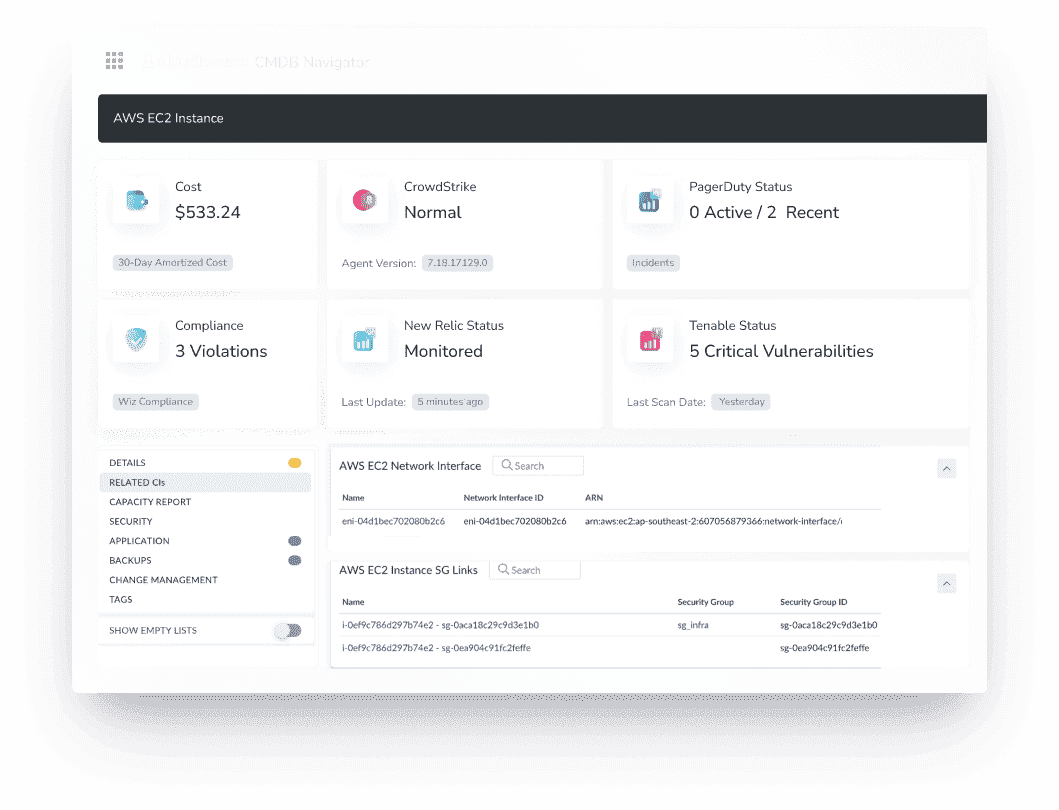
What makes a CI different is its relationship to other items in the infrastructure. You need to understand not just what it is, but how it connects to other systems, services, or processes.
CIs are tracked in your CMDB (Configuration Management Database) to ensure everything is in sync and running smoothly.
For example: You’ve got a cloud-hosted web application running across AWS and Azure. It includes EC2 instances running apps on AWS, Azure SQL Databases for user data, and the VPC and virtual networks linking them.
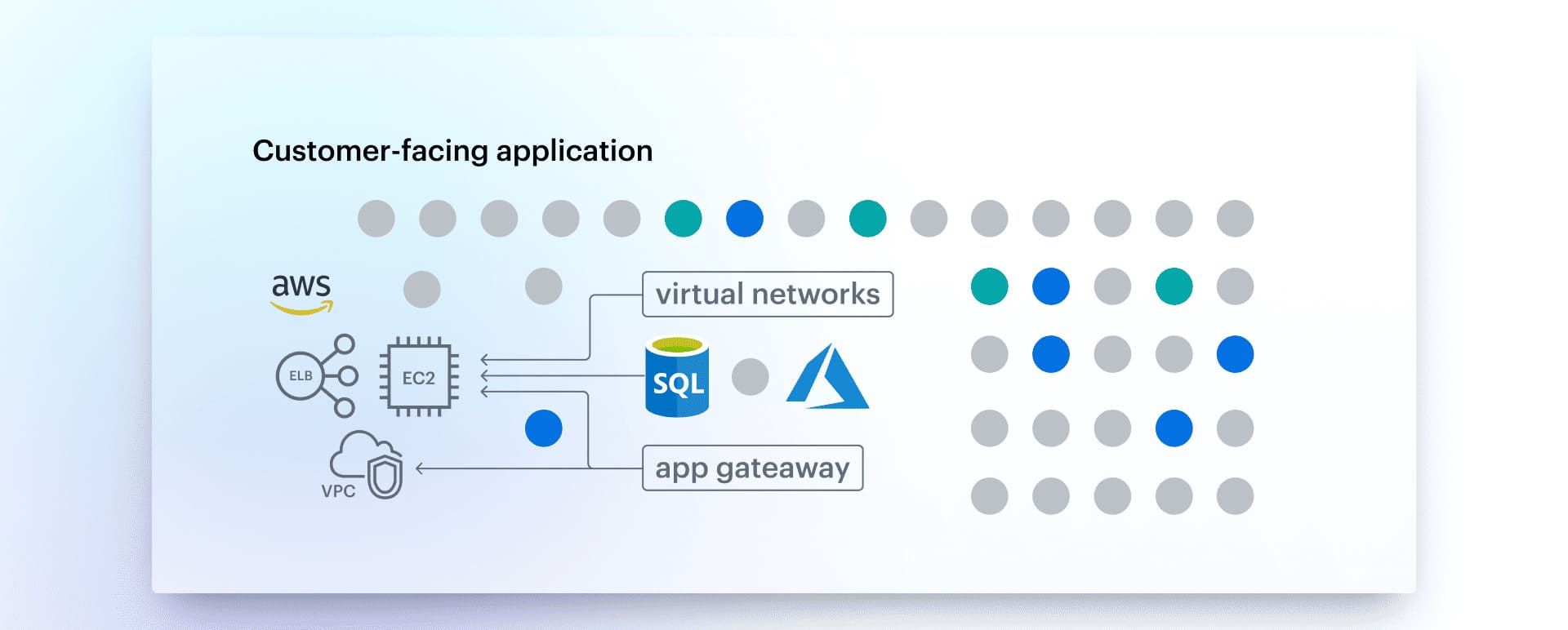
Each element is a configuration item. Why? Because they depend on each other.
Example: Server as an Asset vs. CI
We always joke that servers are like that one friend who’s great at parties and also secretly holds your whole life together? Well, turns out, servers have a bit of a double life in IT too. They’re both assets and configuration items — just not at the same time, or in the same way.
👉 The “asset” side of your server
Think of it like this: when your finance and ops teams look at a server, they see dollar signs. In asset management, it’s all about ownership, cost, and lifecycle. That’s the heartbeat of ITAM vs CMDB debates.
Your asset management tool will be drooling over:
Purchase price and depreciation
- SLAs and warranty timelines
- Maintenance contracts (like those vendor support calls nobody wants to be on)
- Lifecycle: is it humming along, almost toast, or ready to be e-waste?
- Serial numbers, asset tags, insurance — all the bits that make audits and budget forecasts tick
Why? Because in the CMDB vs asset management story, the asset lens is about controlling spend, staying compliant, and not letting something expensive fall off the radar.
👉 The “CI” side of your server
Now slide on your infra architect hat. When we pop into the CMDB, that same server is living a totally different life — as a configuration item. Here, we care about its technical guts and how it dances with the rest of your environment.
So the CMDB will geek out over:
- OS versions and patch levels
- Installed apps and middleware stacks
- Config tweaks that make it unique
- Network hookups — who’s talking to whom
- Who’s got access, what roles, and when stuff changed
Because in the world of CMDB IT asset management, the focus shifts. It’s not how much did this cost? — it’s what role does this play in my ecosystem, and what blows up if it goes sideways?
👉 Why the difference matters
This is where the magic of CMDB vs ITAM comes in.
- If your CFO walks in, they’re gonna care if that server is fully depreciated or still under warranty.
- If your security team pops by, they’ll care if it’s missing a critical patch that could bring down production.
- And if something breaks at 2 AM, your on-call engineer will want the CMDB view — how it connects to databases, which apps rely on it, and what downstream services are in the blast radius.
So yeah — same physical box, two totally different stories. That’s the real juice in understanding the difference between CMDB and asset management. It’s not just a technical vs financial split — it’s literally two ways to protect your org’s money and its uptime.
That’s why when folks ask me about CMDB and asset management, I always say: you wouldn’t want to live without either. It’s like trying to manage your personal finances with only your checking account — and no clue what your mortgage or investment portfolio looks like. Both give you essential views, just through different lenses.
Asset vs CI: The Key Differences
When we talk asset vs CI, it’s all about perspective.
Think of asset management like your finance team’s favorite child — it’s obsessed with ownership, cost, and lifecycle. Is the server under warranty? What did we pay for it? When’s it due for refresh?
Meanwhile, a CI is IT’s golden retriever. It’s all about functionality, relationships, and impact inside your tech ecosystem. A CI doesn’t care how much you paid — it cares how that server’s configured, what it talks to, and what might break if it suddenly poofs out of existence.
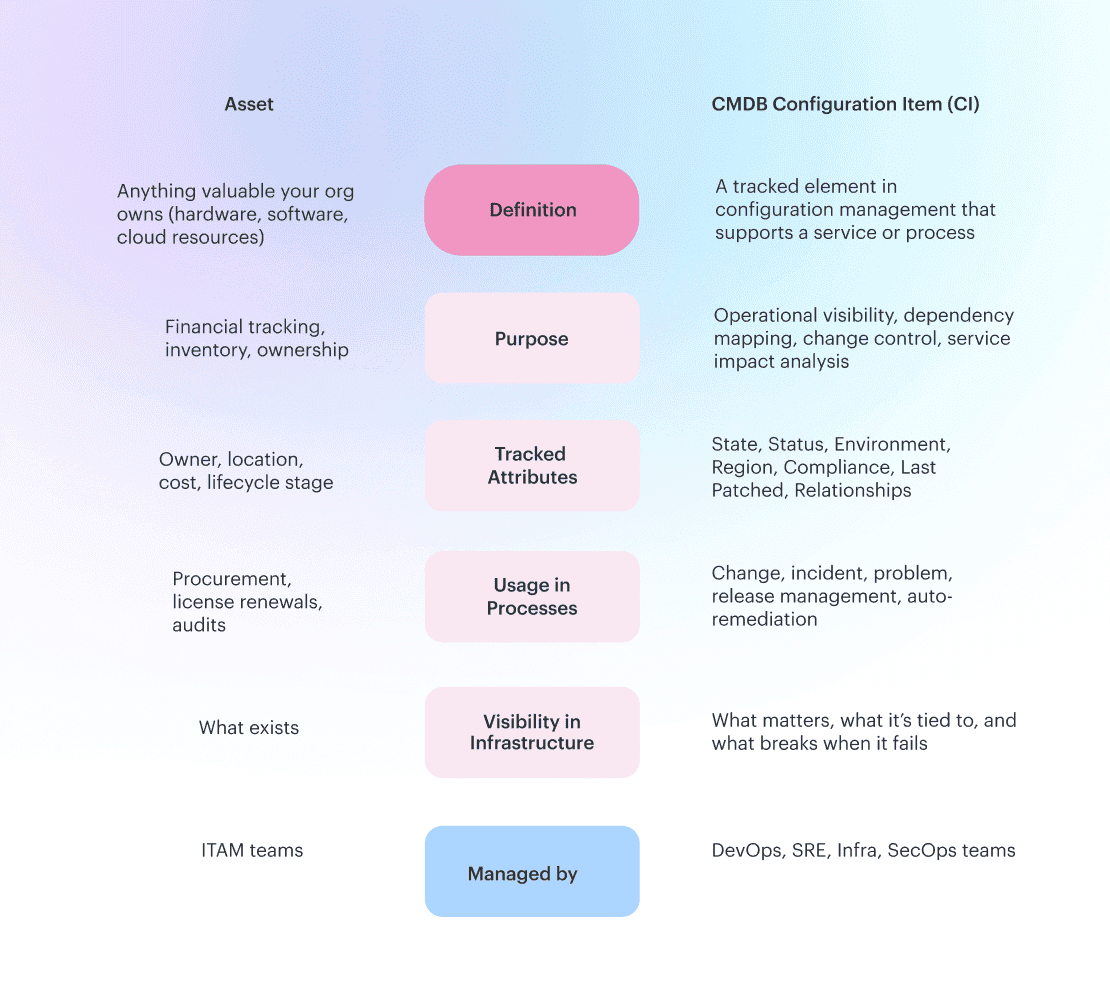
Information tracked?
- Asset management is like your spreadsheet hero: cost center, warranty dates, physical location.
- CIs in the CMDB? They’re nosy — they want OS versions, patch levels, network connections, even which microservice is whispering sweet nothings to which database.
Role in IT management?
- Assets keep your bean counters happy — managing value and depreciation.
- CIs keep your engineers sane — making sure operationally everything runs and plays nicely together.
That’s the real difference between CMDB and asset management (or if you like the fancy jargon: ITAM vs CMDB).
What is CMDB?
Picture your IT estate like a sprawling city. The CMDB knows every street, every coffee shop, who delivers to who, and which road construction will turn your commute into a nightmare.
Technically? A Configuration Management Database (CMDB) is your central, living record of all IT assets (yep, even your sad old on-prem servers) plus how they’re stitched together.
It’s way more than a list.
- It auto-discovers stuff — cloud VMs, containers, databases, network gear.
- It grabs all the juicy config details: what OS is running, who’s connected to what, dependencies across AWS and Azure.
- It maps out relationships like a social graph for your infrastructure: “this web app depends on that API, which talks to that DB in GCP.”
- It tracks every change, patch, and sneaky config tweak so you never get blindsided.
- It plays nice with your ITSM tools, telling incident, change, and asset management what’s up.
That’s CMDB IT asset management synergy right there.
Why it actually matters
Imagine you're running IT Ops at BigCorp, wrangling multi-cloud, hybrid beasts, and basically living on caffeine. Your secret weapon? The CMDB.
One morning — BAM 💥 — critical service goes down. Old world? You’d be doom-scrolling outdated Visio diagrams, pinging half the team on Slack, piecing together who changed what last week.
But now? You open the CMDB. In seconds, you see the chain: 👉 A config change in GCP broke a link that fed data to a web server in AWS.
You roll it back. Crisis over by 7:15 AM. At 7:16, you're smug-posting in the team chat: “All sorted 😎.”
No CMDB? She’d still be in war room hell, trying to figure out what even broke.
Ok, but how it is different from IT asset management?
What is asset management?
If you’ve ever had your CFO breathing down your neck asking, “How many servers do we actually have on AWS? What’s our depreciation on those? Are we still paying for gear that’s gathering dust?” — that’s where IT Asset Management (ITAM) comes storming in like a rescue squad.
Asset management isn’t some shiny tool — it’s a process.
It’s all about managing the lifecycle of your assets, end to end. From the second you swipe that corporate card to buy a load balancer or a pile of laptops, all the way until you’re decommissioning it and shipping it out for recycling.
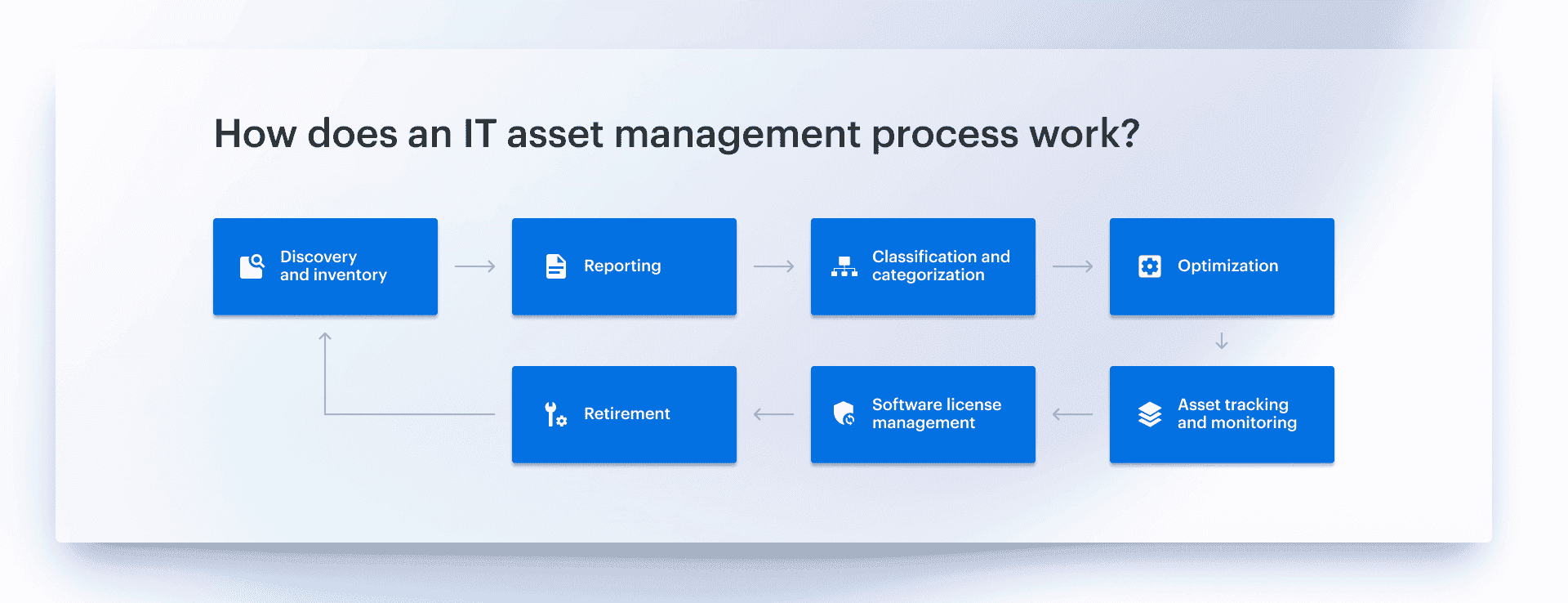
Think of ITAM as the financial backbone of your tech landscape. It answers:
✅ What do we have?
✅ Where is it?
✅ Who owns it?
✅ How much is it worth right now vs. when we bought it?
✅ When is it going to cost us again?
So how’s this different from your CMDB?
- Your CMDB is laser-focused on how things are connected. It’s your blueprint of configuration items (CIs) and how they all dance together — that’s your app servers linked to databases, load balancers routing to APIs, all that beautiful topology.
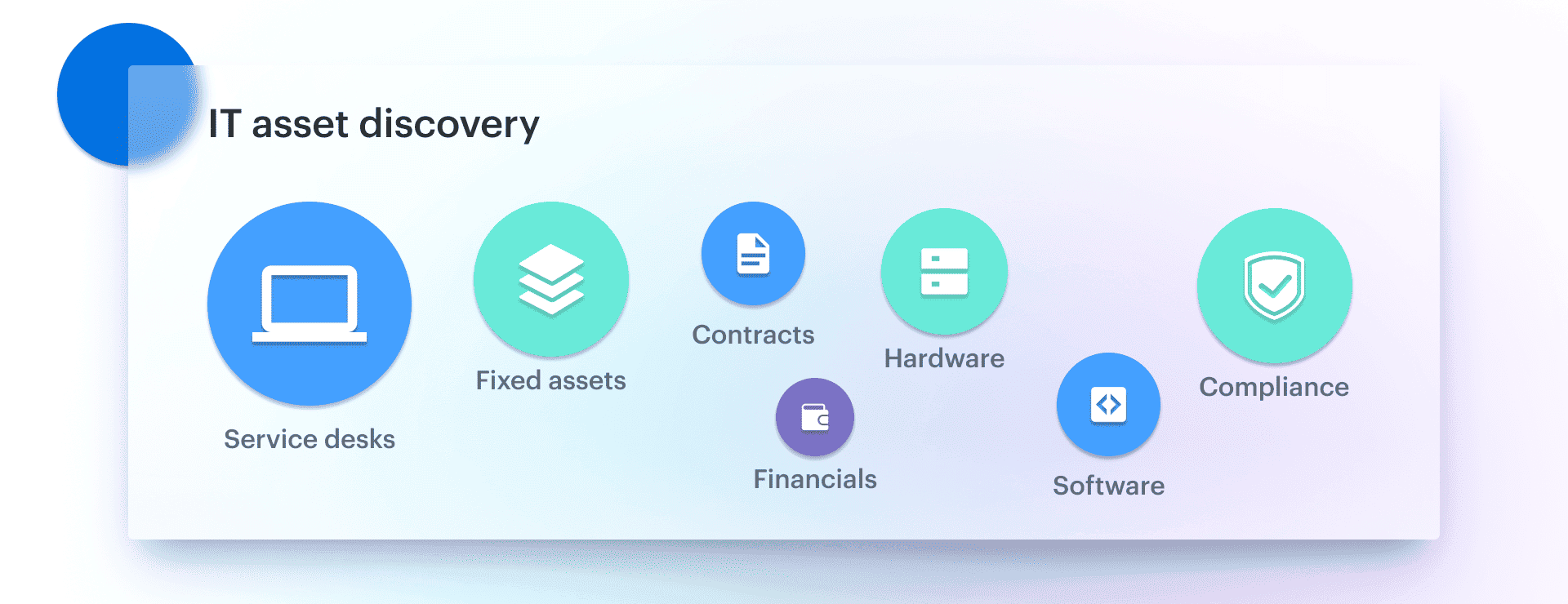
- Meanwhile, ITAM couldn’t care less if your database clusters are best friends with your caching layer. It wants to know: How much did we pay for that hardware? When does that software license expire? What’s it costing us each month to keep that cloud instance alive?
That’s the big difference between CMDB and asset management, or CMDB vs ITAM in all those Google searches.
Where this really bites is when you’re scaling or tightening budgets. If you’re multi-cloud (and let’s be honest, who isn’t these days?), you’ve got AWS, Azure, maybe even some GCP sprinkled in, plus on-prem racks still humming along.
Without a solid asset management process, you’re one invoice away from finding out you’re paying for zombie assets nobody uses. Or worse — you realize after a critical warranty expires that you’re on the hook for a mega support bill because no one flagged it.
Then there’s compliance. Auditors don’t care about your CI relationships. They care if your software licenses are current, if you’ve documented ownership, if your asset registers are clean.
When you’ve got ITAM humming along with your CMDB, that’s how you sail through audits.
- CMDB gives you the config and relationship maps.
- ITAM gives you the purchase orders, the cost trails, the depreciation logs.
Together, they shut auditors up fast.
The real kicker? Cost. A lot of folks think ITAM is just about tracking stuff. Nope. It’s about controlling spend. Without it, you’re probably overpaying for support contracts on gear you could have replaced, or renewing cloud resources nobody’s touched in six months.
A mature configuration management + asset management combo is how you start spotting savings, squeezing more out of budgets, and justifying every new request to finance with actual data.
So if you’re ever stuck untangling CMDB vs asset management, here’s the bottom line for you and your team:
- CMDB is your technical truth — how everything connects.
- ITAM is your financial + operational truth — what it costs, who owns it, where it is in its lifecycle.
Pair them up, and you’re not just running IT — you’re running it like a boss.
Key differences between CMDB and asset management
Let’s break down the key differences between Asset Management and CMDB — or, as some like to say, ITAM vs CMDB. At first glance, they might seem similar, but they serve very different purposes.
Let’s dive into their focus areas, value propositions, tooling, and use cases.
Focus
Asset Management (ITAM) is all about tracking the lifecycle of assets. It focuses on the financial and operational side — how much an asset costs, when it’s purchased, maintained, and decommissioned. It tracks things like warranties, insurance, and contract details.
CMDB, on the other hand, focuses on the technical side of things. It tracks configurations, relationships, and dependencies between assets. It’s about how your servers, applications, and devices work together in a larger ecosystem.
In short:
- Asset Management = Financial and lifecycle tracking.
- CMDB = Technical and operational tracking.
Value
Asset Management helps you optimize your budgeting and cost management. It ensures compliance with licensing agreements, insurance policies, and vendor contracts. It’s the go-to for making sure you’re not overspending or missing critical warranties.
CMDB, however, is your go-to for operational visibility. It offers insight into your IT environment’s health, performance, and dependencies. If ITAM vs CMDB is the question, the answer is clear: Asset Management is about financial health, and CMDB is about operational health.
In short:
- Asset Management = Save money, stay compliant.
- CMDB = Keep everything running smoothly.
Tool stack
When it comes to tooling, ITAM vs CMDB plays a big role in choosing the right tools. Asset Management integrates with tools for financial data, inventories, and vendor management. This streamlines processes and improves efficiency. These tools are great for tracking purchase history, lifecycle status, and cost.
CMDB tools, on the other hand, focus on CIs discovery and their relationships. Think Cloudaware CMDB, ServiceNow, or BMC Helix. These tools are built to keep a close eye on your infrastructure, detect changes, and maintain visibility of your entire IT ecosystem.
Read also: Choose an ideal ITAM software: Top 15 asset management tools
Use Cases
Asset Management (ITAM) is used when you need to:
- Control costs — tracking asset depreciation and value.
- Ensure compliance — ensuring licenses and warranties are up to date.
- Plan for upgrades — keeping track of when things are due for replacement.
CMDB is used when you need to:
- Understand relationships — how your servers are connected to apps, databases, and networks.
- React to changes — track configuration changes, patches, and incidents.
- Troubleshoot — quickly pinpoint where issues are occurring across your infrastructure.
Where asset management and CMDB overlap
You’re running thousands of moving parts across AWS, Azure, and GCP — plus the good ol’ on-prem stuff that refuses to die. Your Terraform pipelines are humming, Jenkins is churning out builds, your ServiceNow Change Requests are piling up, and meanwhile your CFO keeps poking you for clean numbers.
Now here’s where asset management and CMDB start stepping on each other’s toes.
👉 The overlap in real life
Let’s say you’ve got an EC2 instance running in us-east-1. It’s more than just an instance, right?
- In asset management, it’s tracked for its cost center, budget allocation, maybe even linked to a depreciation schedule or some maintenance contract SLA your procurement team negotiated.
- But in the CMDB, it’s alive as a CI with a whole constellation of metadata — its AMI ID, security groups, attached EBS volumes, VPC peering relationships, even tags like
Environment=Prod,App=CustomerPortal,Owner=DevOps.
Same machine, two worlds — overlapping right there in your daily operational story.
👉 Lifecycles & dependencies are where it gets spicy
Say you’re about to retire a fleet of Windows Server 2012 VMs in Azure because your security team flagged them as a compliance risk on the last audit.
- Asset management needs to update the books: close out the lifecycle, adjust the depreciation model, maybe free up license pools tied to that fleet.
- But your CMDB is the only place that really knows the dirty details — which load balancers route to those VMs, which app microservices are talking to them over RabbitMQ, which third-party API credentials are hardcoded in their configs (don’t get me started…).
If you don’t see that overlap clearly, you’re flying blind. You could shut down infra and have half your production pods start throwing 503 errors because no one mapped the dependency chain.
👉 Change management dances on this overlap too
When your team runs a patch job via Ansible on a batch of GCP Compute Engine instances, your CMDB records the config drift, updates the OS patch level, ties it to a ServiceNow Change record.
Meanwhile, asset management is logging the event from a contract or warranty perspective — maybe that patch is tied to a vendor maintenance agreement, or affects your support tier with Red Hat.
Same event, two vital narratives.
👉 And compliance & audits
You know how your auditors always want evidence that:
- Your CIs are hardened to your baseline (like CIS Level 1),
- You have a clean chain of ownership and licensing for every server touching customer data?
That’s where asset management ensures the financials and entitlements are spotless, while your CMDB proves the configuration posture and network relationships.
When GDPR or HIPAA auditors swing by, if these two aren’t in sync, your team ends up in a 3-week email chain pulling logs, invoices, and terraform state files from five different people.
👉 The deep insight? Asset management and CMDB aren’t just overlapping — they’re tangled up in almost every process that matters:
- Discovery & classification: pulling AWS Config snapshots, feeding them to your CMDB, cross-tagging with asset ownership.
- Change management: from your CI/CD GitLab merges that trigger infrastructure updates, to the ITIL workflows tracking approvals.
- Incident management: when PagerDuty blows up at 2 AM, your CMDB tells you what’s downstream; asset management tells you who paid for it and whether you can spin up a fresh node under the same contract.
- Compliance & audit trails: proving that everything running in
us-central1is properly licensed, up-to-date, and inside your encrypted VPCs.
When your CMDB and asset management are tightly woven — think automated discovery, proper tagging, linking assets to CIs at ingestion — you unlock this beautiful orchestration. Your DevOps gets clarity on infra changes, your security team can actually sleep, finance stops breathing down your neck for cost models, and you survive audits without sweat.
And that, my friend, is where the CMDB and asset management overlap goes from being a confusing tangle to your slickest power move.
Anytime you wanna map this in your own estate, grab me — I’ll even draw it out on your whiteboard with those squeaky neon markers we both hate.
Summary table
| CMDB | IT Asset Management | |
|---|---|---|
| Primary Focus | Configuration and relationship between IT assets and services | Tracking the lifecycle, cost, and financial aspects of IT assets |
| Key Purpose | Maintain visibility and management of technical configurations, dependencies, and relationships | Manage asset lifecycle, costs, warranties, and compliance |
| Type of Data Tracked | Configuration details like OS, installed software, settings, dependencies | Financial data, purchase costs, warranties, maintenance, lifecycle stages |
| Visibility Provided | Focus on how assets interact within the IT ecosystem, especially configurations | Focus on financial and operational visibility (e.g., depreciation, cost tracking) |
| Tracking Method | Dynamic – Tracks real-time changes, relationships, and dependencies | Static – Focuses on asset state over time, including purchases, maintenance, and retirement |
| Use Case | Troubleshooting, change management, incident management, and dependency mapping | Budgeting, auditing, cost control, and ensuring proper warranty or support coverage |
| Tooling | Integrates with ITSM, change management, and service mapping tools | Integrates with financial systems, procurement tools, and licensing management systems |
| Example | A server in a multi-cloud environment: OS version, patches, network connections | The same server: purchase cost, warranty details, insurance, and lifecycle status |
| Relationship Management | Tracks dependencies between assets and services (e.g., web server depends on database server) | Primarily tracks ownership and financial relationships (e.g., which department owns the server) |
| Lifecycle Focus | Tracks configuration changes during the asset's lifecycle (e.g., updates, upgrades) | Focuses on asset stages: purchase, warranty, maintenance, and decommissioning |
| Integration with ITSM | Plays a core role in incident, change, and problem management | Can integrate with financial systems but is typically not part of ITSM workflows |
| Reporting | Focuses on technical health, configurations, and dependencies (e.g., security, performance) | Focuses on costs, asset status, and financial optimization |
| Compliance Role | Ensures the security and regulatory compliance of configurations (e.g., patch management, GDPR) | Ensures licensing compliance, contract management, and financial audits |
CMDB and asset management: Which should you use?
Short answer? It’s never about picking one over the other. That’s like asking whether your car needs an engine or wheels. The real magic is how they work together.
Here’s how it breaks down:
- CMDB is your tech brain. It tracks configurations, maps dependencies, and basically keeps a live blueprint of how all your stuff fits and talks to each other.
- IT asset management (ITAM) is your financial strategist. It watches ownership, warranties, contracts, and total spend — keeping your budgets tight and renewals on track.
Read also: 10 Steps to IT Asset Management Strategy For Multi Cloud Setup
Let’s say your CMDB shows your customer portal depends on a cluster of app servers that, surprise, are still tied to an ancient database. Meanwhile, your ITAM flags that those servers are three months from warranty expiration, with support costs set to spike 30%.
See where this goes? Without both views, you’re either risking stability or burning cash — or both.
Or take software licenses. Your ITAM sees how many you’ve bought, when they expire, what the renewal costs look like. Your CMDB links those licenses to actual running services, so if usage dips or shifts, you can scale down before finance gets grumpy.
Practical tips for bringing it all together:
✅ Automate your discovery. Make sure your CMDB pulls fresh data from your AWS, Azure, and on-prem environments. Otherwise, it’s basically a stale spreadsheet.
✅ Sync tags and naming conventions between ITAM and the CMDB. That way, you can tie costs directly to live configs.
✅ Schedule regular reviews where ops and finance both show up. Sounds simple, but so many teams run these in silos — and that’s how zombie costs slip through.
Why does this matter so much?
Because configuration management (via your CMDB) keeps your environment stable and helps you respond to incidents without guessing. IT asset management makes sure you’re not overspending on gear that’s aging out or licenses that no one’s using. Together, they give you that 360° visibility that’s absolutely essential if you want to avoid surprises — whether it’s an outage or an ugly invoice.
So bottom line: It’s never CMDB vs ITAM. It’s CMDB and asset management, working as a dynamic duo. That’s how you keep everything visible, efficient, and under control — without losing sleep (or budget).
Boost your CMBD and asset management capabilities today with Cloudaware
To manage your hybrid infrastructure, you need a unified solution. It should seamlessly combine the power of CMDB and IT asset management.That’s where Cloudaware comes in.
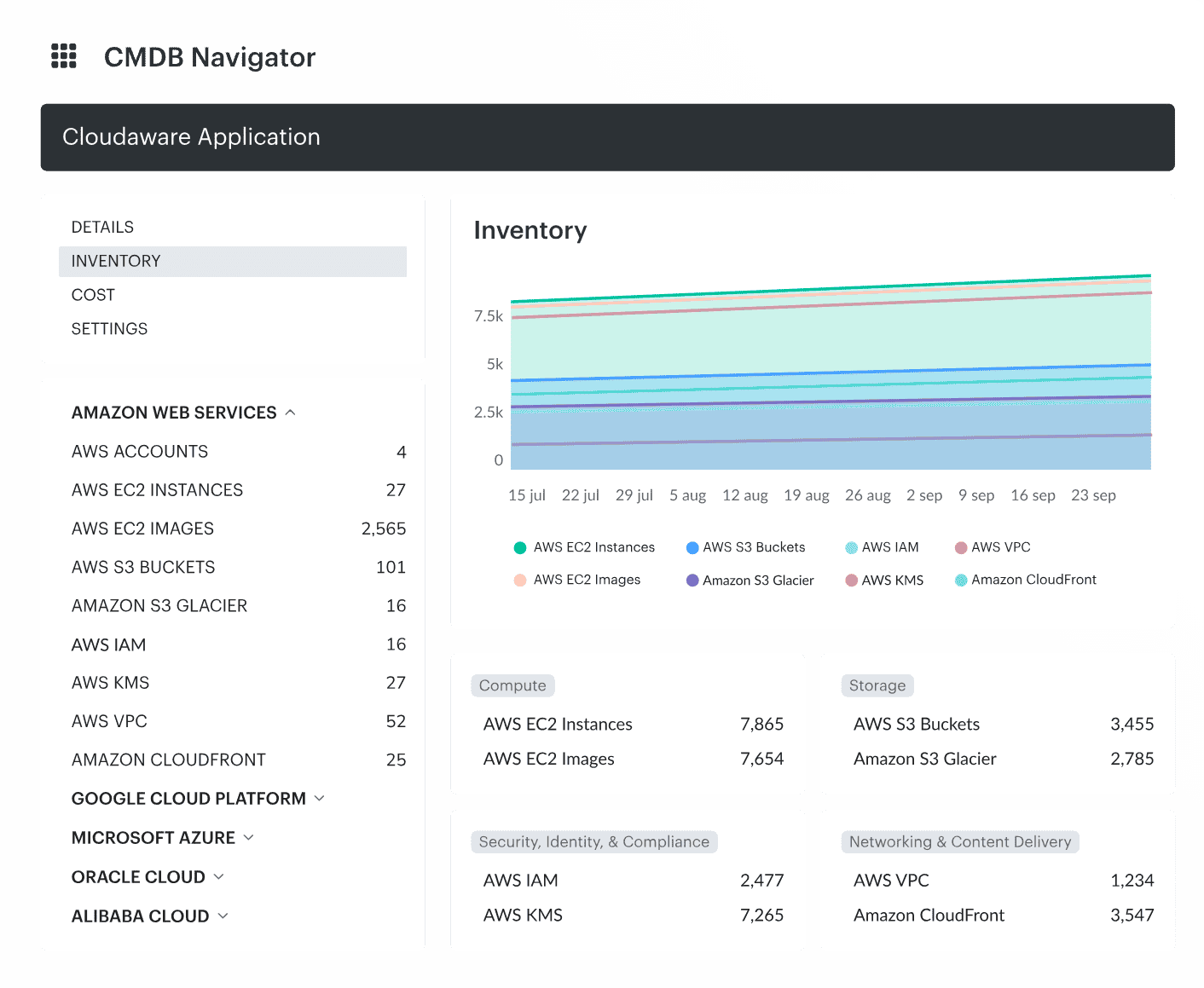
With Cloudaware, you get the best of both worlds.
- CMDB tracks all your configurations, dependencies (such as relationships between servers, applications, and network components), and relationships across clouds and on-prem systems.
- Asset management capabilities to keep tabs on purchase costs, warranties, and lifecycle of your IT assets.
Cloudaware allows you to manage both the technical and financial aspects of your infrastructure — in one place. Whether monitoring servers in AWS, GCP, or on-prem hardware, you get real-time visibility and control.
